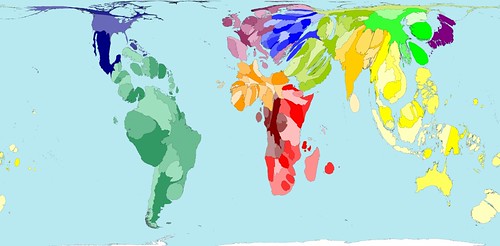tags: endangered species, endangered birds, world map, birds
"... species such as the house sparrow, snipe, starling, lapwing and corn bunting have been listed as birds of European concern, but these species have been declining in the United Kingdom's countryside for decades." Mark Avery, 2004.
A total of 9934 bird species were assessed for threatened species status by 2004; 1213 species were at risk of global extinction. In Indonesia 121 bird species were at risk of local extinction; in Brazil, 120 species. On average, over 18 bird species were at risk of local extinction per territory. [larger view].
Image: WorldMapper.
Hattip to my friend, Scott.


I figure Antarctica has the most birds, since it's so big they couldn't fit it all on the map.
In Australia, we have an abundance of house sparrows and starlings brought in from Europe by acclimatisation societies. They are pest species, so we could probably collect a few container loads and ship them back to Europe. Any takers?